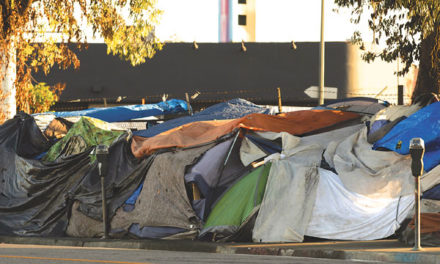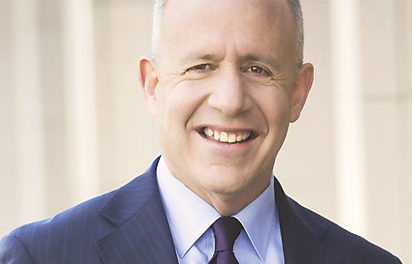Meet the Candidates
Inside Sacramento poses questions to contenders for District 3 seat
February 2020
For the first time after four previous elections, Susan Peters’ name will not appear on the ballot due to her decision not to seek re-election for the Sacramento County Board of Supervisors. As a result, five candidates have filed to run for the Third Supervisorial District in the March nonpartisan primary election.
District 3 includes the unincorporated areas of Arden-Arcade, Carmichael, Fair Oaks, Foothill Farms and North Highlands, as well as Campus Commons in the city of Sacramento.
If one candidate captures 50 percent of the votes plus one, that individual will be the winner. Otherwise, there will be a runoff in the November general election between the top two vote-getters from the primary election.
Inside Sacramento contacted each of the candidates after the filing period ended and asked them to provide information about themselves and their candidacies. As a public service, following are the responses from those candidates who replied by our deadline.
The current Board of Supervisors has banned marijuana retail sales and commercial grows in the county. Do you support the current approach or would you change that?
Rich Desmond
I support the current approach from the perspective that the cannabis industry is a new industry in this state. It is subject to a regulatory structure that is relatively new, confusing, with a lot of loopholes, and is evolving.
We have an obligation to establish a regulatory structure that sets clear expectations for people who want to engage in commercial cannabis activity. The issue is that the City of Sacramento is taking advantage of revenue opportunities that the county is missing out on.
When I’m supervisor, I am not the kind of person that’s going to never say never to an idea. We would need a very good regulatory scheme in place, and it would have to be done on a pilot program basis.
While I was with the California Highway Patrol, I was the legislative liaison for the CHP. I take pride in the fact that that I helped educate the cannabis industry about the regulatory and legal responsibilities of transporting cannabis on our unincorporated and state highways.
Gregg Fishman
I would like to change it. We can drive across the city limit and buy it in dispensaries in the city. Cannabis can be delivered to unincorporated areas because state law requires it. It makes no sense that it’s illegal in the county and we’re missing out on all the tax revenue.
I support a fairly restrictive cannabis ordinance that allows cultivation and sales under very strict circumstances. We do not want them too close to schools, not too close to churches, not close to other public institutions. Cannabis is part of the fabric of our society, whether we like it or not.
Tiffany Mock-Goeman
By concentrating cannabis sales in the city, we’re doing a disservice to the community. I would support expanding grows and retail sales outside of the city limits. There’s a lot of impact around cannabis growing. In South Sacramento, indoor growing has created a huge impact for businesses that rely on commercial space. I would support learning more and possibly expanding cannabis production and sales.
County Department of Transportation says many of the roads in District 3 need to be repaved. But transit advocates want more money to be allocated to regional transit for light rail and buses. What is your priority—roads or transit?
Rich Desmond
This is a conflict that’s been going on in District 3 for a long time. This is a district that does not have a lot of transit options—light rail only provides limited service and bus transit has historically not proven to be a more efficient commute option. People in District 3 rely on their cars. Like it or not, that is the reality. As a supervisor, my priority is going to be to fix the infrastructure, the roads.
One of the most important things government can do is make sure we have appropriate public infrastructure, so people can use it to get safely to work or to school. Sacramento County has an $800 million maintenance backlog for its roads. We only have about $35 million per year to spend towards this backlog. This is going to be a huge priority of mine to improve our efficiency in how we spend these dollars.
Gregg Fishman
I don’t think this is an either-or question. We need to do both. Clearly, we need to have light rail do more and we need to have more bus service. Not only to get people to and from the light rail stations, but also within the district.
That doesn’t mean that we should ignore the streets and roads that are in terrible condition—we have to find a way to do both. We do have more state money coming in from the gasoline tax. We need to make sure that that’s being allocated in a fair manner.
It’s incumbent on the supervisor who represents District 3 to fight extra hard to make sure we’re getting more than a fifth of the money for streets and roads. This is because we have so many more miles of high-traffic streets and roads than any other district, mostly due to how most of District 3 is unincorporated and does not receive city services.
Tiffany Mock-Goeman
We have a housing crisis and we should avoid sprawl. By building commercial and mixed residential, we can create a larger tax base without creating more sprawl.
We need to look at how to create a bigger tax base so we can fix the roads, but we also need to fix Regional Transit. We don’t have a robust transit system and we don’t have housing and living environments conducive to public transit use. By building along commercial corridors with mixed commercial and residential areas, we can justify better bus routes.
The sheriff is an independently elected official responsible for law enforcement for the unincorporated area. During tough budget times the Board of Supervisors has to make the difficult decision between supporting his public safety programs versus cutting to fund social services. What side would you support if this situation arises?
Rich Desmond
If it ever comes to a situation where we have to choose between funding public safety or cutting some kind of social services, my first option will be to meet with the sheriff, other county public safety representatives, and the heads of social services departments and see if we can resolve the issues without cutting essential programs.
However, I am a public safety supporter. I have been an officer with the California Highway Patrol for 24 years. My priority is to make sure people are safe where they live, where they work, and where their kids go to school. In the unfortunate situation where I have to make a choice, I am going to defer to making sure people are safe first.
Gregg Fishman
I don’t think we can balance the county budget on the backs of the people that are most in need. What concerns me most about our Sheriff’s Department is not the money they’re spending on their own budget into public safety, but the money lost from legal settlements after claims of abuse. We need to get a handle on that first and stop the number of lawsuits resulting from treatment at the jail.
Tiffany Mock-Goeman
I sat through a budget meeting with Sheriff Jones a few years ago. He asked for more money to expand his handgun permit department. The previous sheriff did not issue many permits, but Sheriff Jones basically said he would issue a concealed carry permit to pretty much anyone who applied. Many people do not know this, but the county loses money on every CCW permit issued. The budget committee pushed back and told the Sheriff they would not provide him with more funding. Jones replied he would simply take money from projects important to the Board of Supervisors if he were not given more unrestricted funds.
The sheriff is essentially holding the supervisors hostage. I’m proposing—with input from county legal counsel—a line-item budget veto for the sheriff’s budget, so he cannot continue to hold the board over a barrel.
The sheriff already receives more than 60 percent of the unrestricted budget and, frankly, throwing more money at public safety is not going to make us any safer. No matter how much money you give Sheriff Jones, he’s going to continue to misbehave. He’s going to continue to be a bad manager.
Some commentators say the county Board of Supervisors should cooperate more with the Sacramento mayor and City Council on issues. What are your thoughts since each takes a different approach on marijuana, homelessness and density?
Rich Desmond
I am a huge advocate of cooperation, coordination and collaboration. These are not just county issues or city issues. These are regional issues that we should all be working on together. My approach will to improve the level of coordination and collaboration between our governments. The city and county have different priorities and different resources, so my approaches to addressing tough issues will be different than Mayor Steinberg’s approach. However, there are many areas where we can agree and improve the level of coordination.
Gregg Fishman
These problems don’t stop at the city line or county line. Traffic, homelessness, air pollution and some land use decisions inside the city impact the county and vice-versa. We absolutely need to collaborate more with the city.
It’s not just the city of Sacramento. It’s the other cities within the county as well. I would absolutely encourage more collaboration. It doesn’t mean we give up our autonomy. It doesn’t mean we give up our own decision-making authority at the county. It means we have to look at these problems as the regional issues they really are.
This is especially true of homelessness. Where the city has a huge homeless problem, the county has money from the state to deal with issues like mental health, drug and alcohol treatment. We need to make sure we are collaborating with them on those issues, so the money is being spent as wisely as possible.
Tiffany Mock-Goeman
When I worked for Sacramento Steps Forward, it was frustrating to see the poor coordination, communication and one-upmanship between the city and county. The county has to change its approach on homelessness, density and infill planning. At the county level, we need to coordinate more closely with the incorporated cities, because so much of our funding is tied together.
People move from South Sacramento or to Elk Grove because they want city services. The cities are taking much more creative approaches to bigger community issues. The county should utilize opportunities to partner with the cities to create a symbiotic relationship that is beneficial for everyone and bypassing some of the bureaucracy of large county agencies—many of which appear focused on the status quo instead of progress.
Should the Board of Supervisors focus exclusively on infill development to densify the suburbs and avoid allowing housing growth in outer areas of the county like Cordova Hills and the Vineyard area?
Rich Desmond
I am not an advocate of focusing exclusively on any one approach over another. The county should not focus exclusively on infill, but I would like to attract more quality infill projects. I will encourage more infill that combines retail with residential, especially along large transportation corridors.
As for sprawl in the undeveloped areas, open space is important and avoiding unplanned sprawl is important. I support the rights of people to develop their property as long as it’s done in compliance with the law, regulations and policies, but I also believe in the general plan process and identifying and encouraging where development should occur, to preserve open space and habitat.
Gregg Fishman
No, but I do think we should be providing more incentives to home builders that want to do infill development so they can build more efficiently. More infill development means we don’t have as much transit need, so we’re reducing traffic and we’re reducing pollution.
When we encourage infill, we need to provide the right incentives to builders. Let’s lower the fees. Let’s speed up the permitting processes. Let’s get out of the way and let the voters do what they do. I don’t believe we’re going to be exclusively focused on infill development. I don’t think that’s right.
Tiffany Mock-Goeman
The county should focus on infill for housing needs. Every time sprawl developments are allowed, the county is responsible for building out and funding infrastructure and service improvements to the new areas. Not focusing on infill creates more gridlock on the roads and stress on transit services.
Infill often gets a bad rap because people believe it means there will be a high-rise building on every street corner. But in reality, that’s not what smart infill is. We should look at ways to encourage and motivate people to build within existing development areas.
Do you view the position of supervisor for the Third District, which is 95 percent unincorporated meaning not in a city, as an advocate for suburban values and lifestyle? Why or why not?
Rich Desmond
I am an advocate for a suburban lifestyle, which is the lifestyle of most residents of District 3. One of the reasons I’m running is because I was born and raised in this district. This is an urbanized but unincorporated area with larger lots, less congestion and lower taxes than what you see in the city.
This race is about someone who understands the suburban values and lifestyle of the people who live in this district; someone who understands the issues that come along with a suburban lifestyle. I will be an advocate for our values because those are my values.
Gregg Fishman
My immediate thought was if you ask 10 people what the suburban values and lifestyles are, you’ll get at least 10 answers. They expect a different lifestyle than if you were to live Downtown or where the city provides more services.
Let me put it this way: District 3 is not the largest geographically, but it is incredibly diverse and very large. It spans both the most expensive pieces of real estate in Sacramento County and some of the most blighted and depressed areas economically. So, what does somebody in Wilhaggin in a large home think vs. somebody along the Marconi or El Camino corridor living in an apartment? They’re different things and we need to be responsive to all of our residents.
Tiffany Mock-Goeman
The unincorporated area has many benefits over the densely populated urban areas for those interested in a suburban lifestyle. However, much of District 3 is on the cusp of becoming less and less suburban and much more urban when considering issues like public transit, infill and homelessness.
District 3 is unique in that it’s most of the unincorporated area in the county. Whoever represents District 3 has to really be able to put their feet on both sides of the fence and support everyone. Arden-Arcade is considering incorporation into its own city, and if the voters support this measure, then I support their decision. This would work especially well if other county communities, such as Carmichael and Fair Oaks, voted to incorporate at the same time.
Urbanization is forcing the county into a precarious position: the county needs to provide more and more services traditionally offered by cities, which the county does not have the legal or administrative tools to manage.
The mayor and City Council of Sacramento support erecting large-scale shelters, tiny homes or cabins on large tracts of land and possibly a dedicated area for a tent city to address homelessness. The Board of Supervisors in contrast supports placement in rental homes so not to overwhelm a neighborhood. What’s your view on the different approaches and would support a large-scale homeless shelter in District 3?
Rich Desmond
We need a multi-pronged, compassionate approach to homelessness that includes enough emergency beds every night for every homeless person, more affordable housing, and more treatment for addiction and mental health issues, while making sure our families and property are safe.
The approach the city of Sacramento is using is appropriate for the city because the majority of homeless individuals in Sacramento County are around Downtown. Having large-scale shelters where the homeless population is and where the services are makes sense.
I also support the approach that we have taken in the county, which is to have more scattered-site shelters. It doesn’t make much sense to build a large-scale shelter in District 3 because we don’t have large concentrations of homeless. A large-scale, low-barrier shelter would have a huge negative impact on a residential area if it was not planned and developed in an appropriate area.
But homelessness is not simply about finding more shelters and more transitional housing. It is a mental health crisis. It is an addiction and substance-abuse crisis. This problem has to be approached in a multi-faceted way because it has so many causes.
Gregg Fishman
No, but I think we do need to do more to support the city in doing what it plans to do. If the city is going to erect a large-scale homeless shelter somewhere, we need to ensure the county is there to provide county services. Services such as mental health, drug and alcohol treatment are vital services to helping the homeless community and are provided by county agencies to anyone, whether they live in incorporated cities or unincorporated communities.
An important way District 3 can help with housing the homeless is with some infill development. That includes the concept of inclusionary housing. If we’re going to provide incentives for people to do infill development, let’s provide additional incentives for them to set aside a small percentage of the units in a given project for affordable housing.
As an example, Sonoma County has a 100 percent rental density bonus. Say a developer has permits to build 50 units on a 10-acre parcel. If the developer agrees to set aside a certain number of units for affordable housing, the developer can double the density in that project. Let’s provide some incentives for developers to build both infill and the affordable housing component we need to address the homeless problem. I do not support a large-scale homeless shelter in District 3, by itself. But we should absolutely be doing our part to help.
Tiffany Mock-Goeman
I would support a large-scale homeless shelter in District 3, as well as shelters in every county district. A shelter in the empty retail spaces on Fair Oaks Boulevard would be a suitable location, thanks to its proximity to where most of District 3’s homeless live and were the county’s service providers are located.
I previously managed the county’s winter shelter program, which provided service and help to more than 100 homeless people for about 130 winter nights. When I first became interested in helping the homeless, the county’s count was around 1,000 homeless individuals. In subsequent counts, we found the number was actually closer to 5,400.
The two fastest growing population segments were disabled and elderly on fixed incomes, as well as working families. This tells us there’s a major issue with housing costs. If prices are rising faster than working-class families and those with fixed incomes can afford, we are worsening the homeless issue.
There needs to be a continuum of care for people engaged in social services. There is no single answer or single program that will solve homelessness. It will take changes on multiple levels of government, as well as changes to the social views on mental health and drug addiction treatment.















